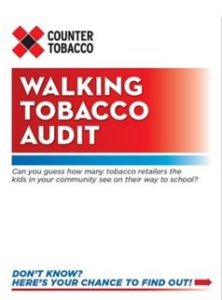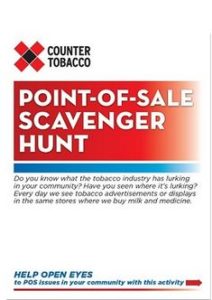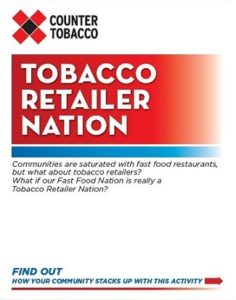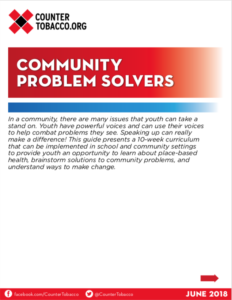Youth and Community Engagement
What’s on this page?
Why engage youth?
The involvement of youth in addressing the problems that face their communities is important in empowering them to work towards improvements in what they and other groups experience, including in the retail environment. Youth engagement can particularly be a key strategy in policy change efforts.
Youth are secret weapons in the fight against the manipulative tactics that the tobacco industry uses to target them. Youth have powerful voices, can be strong advocates, challenge the status quo, offer energy, provide creativity, bring diverse representation, set social norms like around tobacco product use, and mobilize their peers to take action.[1]
When it comes to point-of-sale tobacco control work, youth can highlight the prevalence of tobacco point-of-sale advertising and the effects that such advertisements have on younger generations. Research indicates that exposure to POS advertising has several touch points in engaging consumers to consider tobacco: smoking initiation, continued use, and undermining quit attempts.[2, 3] Research also indicates that youth are three times more sensitive to tobacco advertising than adults. [4] While youth smoking rates have declined over the past few decades, over half a million kids under 18 try smoking for the first time each year, and 235 start smoking regularly each day. Furthermore, the impact of tobacco POS advertising becomes magnified in cases where tobacco retailer density for a given community is particularly high or stores canvased with POS tobacco advertising are located in school zones.
This page provides best practices, activities, and resources for engaging with youth of different ages. The appropriateness of the suggestions below may depend on each specific context and the unique set of capabilities, needs, knowledge, and ages of participating youth.
Best practices for engaging youth
When interacting with youth, it is important to engage properly. Here are a few general best practices to keep in mind:
- Youth are empowered through skill-building and leadership, so activities that allow them to build skills and their leadership qualities are effective[5]
- Working with youth should be mutually beneficial and a partnership for both the youth and adults[5]
- Give youth creative freedom in what they are working on[5]
- Entrust youth in doing what they know best, for example, most youth use some form of social media which can be beneficial when doing media campaigns and community outreach efforts over social media[5]
- Once they are given direction, get youth to engage most with their peers when learning and during activities, as they tend to relate more to their age group[5]
- Give youth options, and don’t just present them with one way to do something or think[5]
- Make it clear that youth are working towards something, like an endgame, goal, or vision[5]
- Ask youth what they want rather than making assumptions[5]
- Get youth to tell their personal stories to help them find connection in the work[5]
- Talk with youth about topics that most interest them and most speak to their experiences such as mental health, e-cigarettes, etc.[5]
- Guide youth in decision-making rather than deciding for them or pressuring them one way or another[6]
- Develop programs and activities “with”youth, rather than “for” youth[6]
- Have youth create the training materials and curriculum which can help in increasing their level of relevancy[6]
- Solicit feedback from youth on a continual basis from implementation of an initiative to the evaluation of it[6]
- Make sure youth are helping to set the agenda for meetings and activities so they have a stake in the result[6]
- Have heightened awareness of the historical and cultural backgrounds of youth by continually asking and talking about their unique experiences for more meaningful engagement[7]
- Make learning more accessible and inclusive through continually addressing youth with disabilities, any equipment/technology preferences, and basic needs like safety and hunger[7]
Activities to engage youth
There are many ways to get youth involved in point-of-sale work. The goal should be to continually involve them and use different methods while doing so. There should be a clear purpose in this engagement.[8] Youth learn and provide the most input through social interaction, challenges, motivation, emotional expression, exploration, and experimentation.[8] When youth are physically engaging, creating things, problem-solving, talking, and have freedom to express themselves fully, they participate the most.[8]
Some general activity ideas for engaging with youth, from the experiences of those working in tobacco prevention and control, include:
- Harnessing their creativity through video, art, and other mediums, such as having a video contest or art showcase
- Creating a media campaign that allows them to express their thoughts and feelings to the general public
- Playing games that reinforce tobacco-related information, like trivia quizzes on facts about the tobacco industry
- Having them develop education materials like flyers and factsheets for community education efforts
- Organizing a youth-led council or board (e.g., a youth leadership board) to harness their leadership abilities
- Teaching them how to write to a local newspaper or magazine to express their concerns
- Bringing them together to watch educational content like videos and movies to teach them about concepts related to tobacco and activism
- Talking to local policy makers to give a youth perspective on issues such as around tobacco marketing and tobacco product exposure
- Cleaning up tobacco litter like cigarette butts (the #1 littered item in the world) from roads, parks, beaches, or at their schools
- Getting them to post on social media about the toll of tobacco and need for action
- Interviewing store owners and clerks to understand the business perspective on tobacco sales and marketing
- Recruiting them to do school presentations or help with trainings to educate their peers and adults on smoking and vaping, the tobacco industry’s influence, and policy options to address these
- Conducting data collection, like store assessments, to document tobacco marketing and sales at the point of sale
There are national events youth can participate in, which allow them to stand up and speak out on a large scale. One such event is “Take Down Tobacco National Day of Action” (previously “Kick Butts Day”) which happens every Spring. “Take Down Tobacco National Day of Action” was started and is led by the Campaign for Tobacco-Free Kids. This national day of action provides a platform for youth activists, educators, parents, health advocates, and concerned citizens to raise awareness of the problem of tobacco use, reject the tobacco industry’s influence, and urge elected officials to take action to protect youth from tobacco. Learn more here about this day and get involved.
Stories from the Field
 Youth activists from various groups have been demonstrating at Big Tobacco company shareholder meetings, including at Philip Morris (now called Altria), Philip Morris International, Philip Morris USA, and Reynolds American for nearly two decades to hold these companies accountable for their actions and demand change. Learn more about the rallies here.
Youth activists from various groups have been demonstrating at Big Tobacco company shareholder meetings, including at Philip Morris (now called Altria), Philip Morris International, Philip Morris USA, and Reynolds American for nearly two decades to hold these companies accountable for their actions and demand change. Learn more about the rallies here.
 Iowa Students for Tobacco Education and Prevention (ISTEP) is a youth-led tobacco prevention movement with a network of local chapters across the state. A chapter in Audubon, IA, a small, rural community in the Southwestern part of the state, used CounterTobacco.org’s Walking Tobacco Audit to uncover the problem of tobacco use and tobacco advertising in their community. During the activity, the students noticed some large outdoor advertising of low priced tobacco products at the Dollar General store, and decided they would all write letters to the Dollar General Corporation and ask them to take the sign down, citing examples of how tobacco advertising is aimed at youth and other populations. The Dollar General Corporation responded by sending a letter back to the group, and took down the sign in Audubon! These large yellow outdoor advertisements were also taken down from Dollar General stores across the state. Read more here.
Iowa Students for Tobacco Education and Prevention (ISTEP) is a youth-led tobacco prevention movement with a network of local chapters across the state. A chapter in Audubon, IA, a small, rural community in the Southwestern part of the state, used CounterTobacco.org’s Walking Tobacco Audit to uncover the problem of tobacco use and tobacco advertising in their community. During the activity, the students noticed some large outdoor advertising of low priced tobacco products at the Dollar General store, and decided they would all write letters to the Dollar General Corporation and ask them to take the sign down, citing examples of how tobacco advertising is aimed at youth and other populations. The Dollar General Corporation responded by sending a letter back to the group, and took down the sign in Audubon! These large yellow outdoor advertisements were also taken down from Dollar General stores across the state. Read more here.
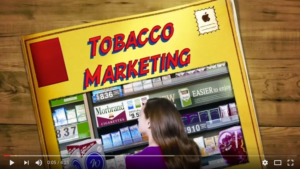 The Tobacco Marketing Education and Awareness Video Project, a joint project between Tobacco Free Action Communities (TFAC) of Ulster, Dutchess, and Sullivan Counties in New York State and the Ellenville High School Media Arts program, was inspired by the January 1, 2016 enactment of Ulster County, NY’s law requiring a local license to sell tobacco and prohibiting new tobacco retailers from operating within 1000 feet of schools. Tobacco Free Action Communities (TFAC) of Ulster, Dutchess, and Sullivan Counties collaborated with the Media Arts production class at the high school, to create the educational videos on how tobacco marketing influences youth smoking. The videos were intended to educate the community on how in-store tobacco marketing is a leading cause of youth smoking. They were aired on the local public access TV station to educate Ulster County residents about tobacco point of sale marketing and will also be used in TFAC’s educational programs. New York State Department of Health, Bureau of Tobacco Control funds TFAC to increase support for New York State’s tobacco-free norm through youth action and community engagement. Ellenville High School Media Arts students were recognized by the Ulster County Legislature on March 15, 2016 with the “Pride of Ulster” Award for their contributions.
The Tobacco Marketing Education and Awareness Video Project, a joint project between Tobacco Free Action Communities (TFAC) of Ulster, Dutchess, and Sullivan Counties in New York State and the Ellenville High School Media Arts program, was inspired by the January 1, 2016 enactment of Ulster County, NY’s law requiring a local license to sell tobacco and prohibiting new tobacco retailers from operating within 1000 feet of schools. Tobacco Free Action Communities (TFAC) of Ulster, Dutchess, and Sullivan Counties collaborated with the Media Arts production class at the high school, to create the educational videos on how tobacco marketing influences youth smoking. The videos were intended to educate the community on how in-store tobacco marketing is a leading cause of youth smoking. They were aired on the local public access TV station to educate Ulster County residents about tobacco point of sale marketing and will also be used in TFAC’s educational programs. New York State Department of Health, Bureau of Tobacco Control funds TFAC to increase support for New York State’s tobacco-free norm through youth action and community engagement. Ellenville High School Media Arts students were recognized by the Ulster County Legislature on March 15, 2016 with the “Pride of Ulster” Award for their contributions.
CounterTobaccco.org Youth and Community Engagement Activities
Counter Tobacco’s Youth Engagement Activities help youth uncover point-of-sale issues in their communities. These activities guide tobacco control advocates in mobilizing youth to address and curb the marketing and presence of tobacco products within their neighborhoods. They are pre-packaged, free interactive lesson plans that include the tools necessary to outline the problem, collect the data, and present a compelling story about point-of-sale tobacco concerns to local decision makers and stakeholders. These activities not only help raise awareness of the tobacco industry’s tactics among youth but empower young people to take an active role in spurring positive change in their communities.
Check out and download our youth engagement activities below!
FOCUS ON BIG TOBACCO: A POINT OF SALE PHOTOVOICE PROJECT
Photos and visuals offer advocates a powerful tool to show others with decision-making power what the industry is doing at the point of sale. This guide uses the photovoice technique to expose the marketing strategies used by the tobacco industry and, by involving youth in the documentation process, to educate communities about the risk of this marketing. Education about the problem and exposing the industries’ tactics are critical components to help tobacco control advocates build support for and enact health-promoting policy interventions.
WALKING TOBACCO AUDIT
POS SCAVENGER HUNT
Youth teams compete to identify the most problematic tobacco industry activities in their area by visiting stores and documenting what they find. Scavenger hunt items include: 20-packs of flavored little cigars priced at less than $2.00 per pack or tobacco products displayed near candy.
See Reality Check youth in Staten Island conducting the POS Scavenger Hunt for Kick Butts Day 2017.
POS BINGO
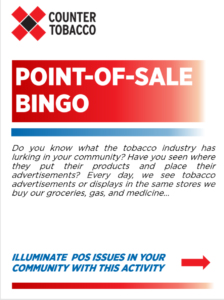
Designed for youth and young adults, this bingo activity encourages participants to visit stores in their community to find and document industry point-of-sale marketing materials and products. The bingo card consists of different pricing promotions, tobacco products, and industry strategies for participants to search for in the retail environment. The first team to find five tactics in a row wins!
TOBACCO RETAILER NATION
Tobacco control advocates map tobacco retailers and fast food restaurants in their community. This activity helps show the density of tobacco retailers- -the number of outlets selling tobacco for a given geographic location or population size- compared with fast food restaurant density. This exercise can create a compelling argument and visual evidence to limit the number of tobacco retailers; for example, nationally, there are about 30 tobacco retailers for every one McDonalds.
ADVOCATE AGAINST YOUTH TARGETING
What if you couldn’t tell the difference between a product that was good for you and one that could kill you? The tobacco industry is betting on the fact that our kids can’t. In this activity participants will play two indoor games designed to teach them different strategies the tobacco industry uses to target youth and the damaging effects of these strategies. Each game culminates in the production of a visual display that your youth group can use to advocate for stricter tobacco marketing policies using the methods outlined in the Media Advocacy Kit included in this activity guide.
POS SCAVENGER HUNT: CAMPAIGN FOR TOBACCO-FREE KIDS YOUTH ADVOCACY SYMPOSIUM ED.
Use this activity to discover and document the influence that Big Tobacco has in your community and craft a plan to do something about it. This activity was created for the Campaign for Tobacco-Free Kids 2013 Youth Advocacy Symposium.
COMMUNITY PROBLEM SOLVERS
In a community, there are many issues that youth can take a stand on. Youth have powerful voices and can use their voices to help combat problems they see. Speaking up can really make a difference! This guide presents a 10-week curriculum that can be implemented in school and community settings to provide youth an opportunity to learn about place-based health, brainstorm solutions to community problems, and understand ways to make change.
LIVING TOBACCO RETAILER MAP
This activity can be used as a companion to Walking Tobacco Audit and Tobacco Retailer Nation. After collecting data, you can share your findings with stakeholders and local decision-makers to impact policy change. Use this human retailer map activity to organize a creative visual display that illustrates the burden of tobacco retailer density in your community and provides evidence to your local government stakeholders for policy change that reduces the burden of retail tobacco in your community.
This activity is in beta form – please try it out and provide us feedback by filling out the following two forms and e-mailing them to info@countertobacco.org:
- For the activity coordinator: Coordinator Feedback Form
- For all participating youth: Youth Feedback Form
Resources
Looking for more guidance?
- Check out the CDC’s Best Practices Guide for Youth Engagement in Tobacco Prevention and Control.
- The Youth Engagement Alliance for Tobacco Control provides a list of external resources and ways to engage with them on their website.
- The Truth Initiative has a page on youth activism such as ways youth can be involved as Truth Ambassadors.
- Find research and facts about youth exposure and access at the point of sale throughout this CounterTobacco.org site and specifically on our page about youth targeting
[5] Truth Initiative. (2022, June 28). Listen Up! Youth share best practices for engaging young people on tobacco prevention [Conference presentation]. 2022 National Conference on Tobacco or Health, New Orleans, LA, United States. www.nctoh.org


